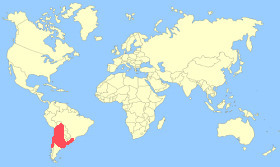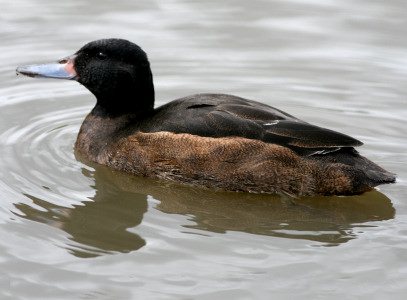Appearance:
Male - The male Black-headed Duck has a black head and upper neck, dark-brown eyes, bluish-grey beak with black dorsal stripe and tip, red around the base of the beak during breeding season, dark-brown upperparts and tail, lighter-brown underparts, brown wings, and legs and feet are grey.
Female - The female is similar except has a brown head and neck with a dark-brown crown, whitish chin and stripe running through the eye.
 |
 |
Size: - Typical Adult is 35-38cm (14-15in).
Food: - Aquatic plants, seeds, insects, and invertebrates.
Habitat/Range: - Swamps, lakes, and marshes in South America - North Chile, Paraguay, Uruguay, south-east Brazil, and North Argentina. Black-headed Ducks in the most southerly regions may move further north during Winter.

 Breeding Habitat/Resident,
Breeding Habitat/Resident,  Migration or Winter Area.
Migration or Winter Area.Breeding Season: - Eggs are laid from September to December.
Eggs: - 5 to 16 (white colour) laid in other bird's nest.
Notes: - The Black-headed Duck is also called the Cuckoo Duck as it will lay its eggs in the nests of other birds such as the Rosy-billed Pochard or other duck,and also the nests of gulls or birds of prey. When the ducklings hatch they are completely independant after only a few hours and are able to fend for themselves. The Black-headed Duck is the only member of the genus Heteronetta but is allied to the Stiff-tail ducks of the subfamily Oxyurinae. These ducks are abundant and classified as Least Concern by the IUCN.
Conservation status (IUCN 3.1):
Least Concern.
Classification: - Family: Anatidae,
Subfamily: Oxyurinae, Genus: Heteronetta.


























